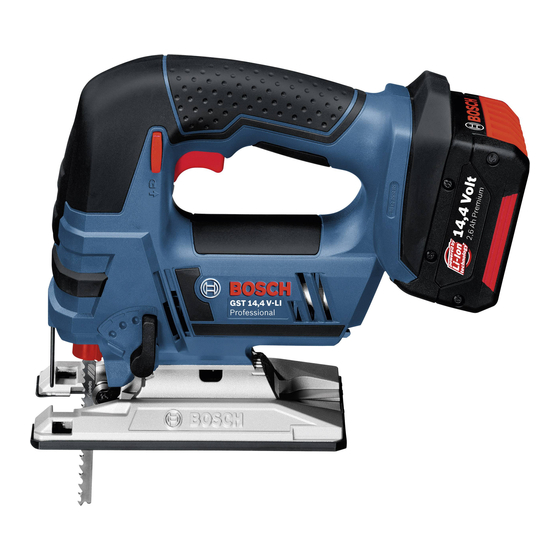OBJ_BUCH-1257-001.book Page 22 Thursday, July 15, 2010 9:04 AM
22 | English
Battery Charge-control Indication
(only for 3.0 Ah battery) (see figure A)
The three green LEDs of the battery charge-con-
trol indicator 16 indicate the charge condition of
the battery 3. For safety reasons, it is only pos-
sible to check the status of the charge condition
when the machine is at a standstill.
Press button 15 to indicate the charge condi-
tion. This is also possible when the battery 3 is
removed.
LED
Continuous lighting 3 x green
Continuous lighting 2 x green
Continuous lighting 1 x green
Flashing light 1 x green
When no LED lights up after pushing button 15,
then the battery is defective and must be replaced.
Replacing/Inserting the Saw Blade
When mounting the saw blade, wear protec-
tive gloves. Danger of injury when touching
the saw blade.
Selecting a Saw Blade
An overview of recommended saw blades can
be found at the end of these instructions. Use
only T-shank saw blades. The saw blade should
not be longer than required for the intended cut.
Use a thin saw blade for narrow curve cuts.
Inserting the Saw Blade (see figure B)
Clean the shank of the saw blade before in-
serting it. An unclean shank cannot be fas-
tened securely.
Insert the saw blade 11 into the stroke rod 17
until it latches. The SDS lever 12 automatically
snaps to the rear and the saw blade is locked.
Do not manually press the lever 12 toward the
rear, otherwise you could damage the machine.
While inserting the saw blade, pay attention that
the back of the saw blade is positioned in the
groove of the guide roller 9.
Check the tight seating of the saw blade. A
loose saw blade can fall out and lead to inju-
ries.
1 609 929 W85 | (15.7.10)
Ejecting the Saw Blade (see figure C)
When ejecting the saw blade, hold the ma-
chine in such a manner that no persons or
animals can be injured by the ejected saw
blade.
Turn the SDS lever 12 forward towards the con-
tact protector 13 to the stop. The saw blade is
released and ejected.
Dust/Chip Extraction
Dusts from materials such as lead-containing
Capacity
coatings, some wood types, minerals and
≥2/3
metal can be harmful to one's health. Touch-
≥1/3
ing or breathing-in the dusts can cause aller-
gic reactions and/or lead to respiratory infec-
<1/3
tions of the user or bystanders.
Reserve
Certain dusts, such as oak or beech dust, are
considered as carcinogenic, especially in
connection with wood-treatment additives
(chromate, wood preservative). Materials
containing asbestos may only be worked by
specialists.
– As far as possible, use a dust extraction
system suitable for the material.
– Provide for good ventilation of the work-
ing place.
– It is recommended to wear a P2 filter-
class respirator.
Observe the relevant regulations in your
country for the materials to be worked.
Prevent dust accumulation at the work-
place. Dusts can easily ignite.
Connecting the Dust Extraction
(see figures D–E)
Insert the vacuum connection 18 into the open-
ing of base plate 7.
Place a vacuum hose 19 (accessory) onto the
vacuum connection 18. Connect the vacuum
hose 19 with a vacuum cleaner (accessory). An
overview for the connection of various vacuum
cleaners can be found at the end of these in-
structions.
To enable optimum dust extraction, use the
splinter guard 20 if possible.
Bosch Power Tools

